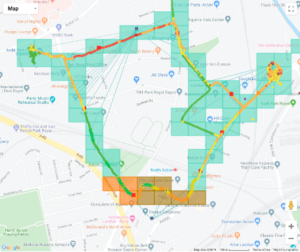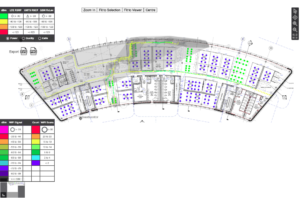Those of you with long memories will remember that back in the 1990s the walls in all mobile phone shops were plastered with coverage maps. Coverage was king and the mobile operators all wanted to show the extent of their own mobile coverage and that theirs was the best, widest, deepest, most extensive. Coverage maps are long since gone of course and these days you pop your post code into the operator’s website to see what the predicted coverage will be. Predicted being the operative word here, especially when it comes to indoor coverage. It’s a handy guide but really doesn’t help when what you need to know is how well the mobile device will work in all the places that it will be used.
We tend to think that coverage is a given these days and we accept that some networks work better than others in some places and not so good in others. This process of self-optimisation tends to teach us the best network for where we use our device the most. The mobile operator advertising pitch has long since moved on from coverage to the latest technology, the data rates, and how much data you can get for your money. But is that all about to change? At Azenby, we think it is.
5G is here. Hooray. Gosh, the new shiny 5G devices don’t come cheap though do they. £75 per month on two-year contracts or the best part of one thousand pounds for a top end Apple or Samsung device. What do we want for all that money? As consumers we want even faster data rates, we think. We want a better data bundle. What we probably need though is to stream high quality video and not be staring at the spinning circle of hell. We also want this to work inside buildings, whether it be in the home, the office, the coffee shop, the train and bus, or the pub. And here lies the new coverage challenge for mobile operators. 5G has to work inside buildings. Not just for the consumer but also for the business user, the enterprise user and crucially, for IoT applications.
In building coverage has always been the big challenge for mobile operators but now in the 5G world it is the new battleground where customers will be won and lost. Mobile Operators have hitherto largely relied on their radio coverage prediction tools to estimate in-building coverage but they have done so in the full knowledge that this is an unreliable method as the construction and internal dimensions of buildings vary greatly and therefore the true in building coverage can be very different to that predicted. That is a problem for 5G services buyers. The only way to really know how good in building coverage is means getting into buildings and testing, which is not a cheap exercise and also has logistical problems to overcome as well.
At Azenby we think the winners and losers in 5G will be determined by who succeeds in providing the best in-building coverage. Not just the best, but really fit-for-purpose 5G coverage. This is not a simple challenge for mobile operators, and some may even leave the in-building problem to others to solve or to rely on WiFi piggyback. We believe those that chose this route will be in the loser’s camp. The new coverage wars, the battle for in-building supremacy, will require new strategies and a new mix of macro and micro layer coverage. It will also require more spectrum of course and in this regard the 5G spectrum at 3.4-3.8 GHz and in the 26 GHz band is a mixed blessing. Yes, it enables services requiring wider bandwidth and for ultra-dense very high capacity networks respectively, but – and this is a very big but – neither band is well suited for penetrating buildings and providing good coverage from the macro network. True, there is some spectrum at 700 MHz and operators can re-farm some of their existing 900 MHz and 1800 MHz spectrum for 5G but 700 MHz is not plentiful and existing spectrum has be managed very carefully to maintain legacy technologies which is where the vast majority of customers are today.
We have all read the about the exciting prospects for 5G and the new use cases which include not only enhanced consumer experience (enhanced mobile broadband eMBB) but crucially, for 5G investment business cases to stack up, the new IoT applications, Massive Machine type Communications (mMTC) and Ultra-reliable and low latency communications (uRLLC). Not exclusively by any means but certainly the need for rock solid inbuilding coverage will be a mandatory requirement for these devices to have universal appeal and ubiquitous availability.
That’s not to say that 5G stand-alone outdoor coverage is a cinch either. Working with our sister company SignalScore, we have been looking at early 5G coverage at 3.4GHz and the results show that it is almost line-of-sight (between base station and device), Whereas that should come as no surprise to radio engineers, it does emphasise that working with 5G spectrum presents a whole new range of challenges for mobile operators.
 In a simple walk round test in London, we found that 5G SA was available for only about 25% of our route and this was in close proximity to the serving cell. For most of the route the device was attached to a 4G bearer.
In a simple walk round test in London, we found that 5G SA was available for only about 25% of our route and this was in close proximity to the serving cell. For most of the route the device was attached to a 4G bearer.
Turning a corner was enough to lose 5G and for the device to drop back to 4G. Although this was a simple outdoor walk test, we think it epitomizes the added difficulties in providing in-building coverage from the macro layer network for mobile operators.
The dilemma extends beyond that of the quality of service that mobile operators can expect to deliver inside buildings. For us, the users and buyers of services, we really do need to know that the 5G coverage we need for our own use case is going to be provided where we need it. With top end devices, as we mentioned earlier, coming in at £1k and the need for high end IoT applications to work as intended, knowing what the coverage quality really is in the buildings we want to use the services is paramount. Coverage prediction is no longer fit for purpose. Decisions need to be made on IoT and 5G device investment with the complete confidence that the services will be usable where we want to use them.
How do we decide on whether the 5G coverage we need is up to scratch? Well first up it is no longer just about the radio signal power level. That is still important, as is the signal quality but there are two other crucial factors that have to be taken into account. One is the data rate, both uplink and downlink, and the other is the responsiveness of the service which is the lag and latency aspect. Our friends at SignalScore have worked on a service that combines these crucial elements into one single score which can be modified for the particular use case in question. We think that this is a major breakthrough for users to be able to go and get a SignalScore for one or all of the buildings that the service is needed for.
SignalScore has developed an easy-to-use service which allows anybody to walk test 5G coverage in their own office, factory, warehouse, mall, shop, restaurant, pub. Knowing the signal score allows more educating buying by understanding which service provider is proving the coverage you need in the building you need to use it in. It is perhaps most valuable though for those people investing in high end expensive IoT services being used for e-health, transport and logistics, smart networks, robotic, retailing, and smart manufacturing. Of course, outdoor coverage is equally important and SignalScore will measure that too.
The concept is simple, anyone with no training can walk around the site and instantly see this scored for the three main attributes required for good 5G services.

Operators themselves can do the same testing as well and this will help them make investment decisions on how to provide excellent in building 5G coverage to their most valuable customers. The main benefit for operators is that this service can be used as an effective filter to help them decide when a full inbuilding survey may be necessary, saving many thousands of pounds per year on unnecessary full engineering surveys.
To go back to where we started, coverage wars are back again, and the battlefield has already been defined. We don’t think we will be seeing the return of coverage maps but we do expect to see a more demanding and better educated buyer of 5G services emerging, putting pressure on service providers to up their game and to rise to the new challenge of 5G in building excellence.
If we can help you get to grips with making sure the 5G coverage you need is fit for purpose why not get in touch with us here.
About SignalScore
SignalScore has a vision to enable competitive and secure wireless experiences for consumers and businesses around the world.
Find out all about it here.